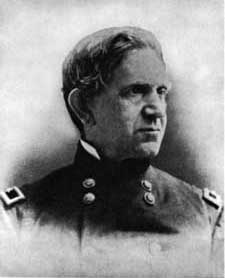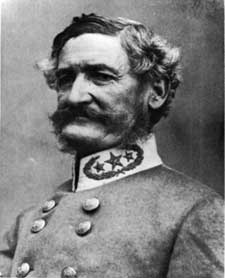|
FORT UNION National Monument |
 |
Outbreak of the Civil War
As the 1850's drew to a close, the great debate waged by statesmen of North and South echoed at Fort Union and other military installations on the southwestern frontier. Part of the Regiment of Mounted Riflemen garrisoned Fort Union. Most of the officers of this unit were Southerners, and they planned to go with the South if war broke out. On February 11, 1861, Lt. John Van Deusen Du Bois wrote in his diary, "Nothing but secession talked of at the post. Of all the officers here only Lt. McCrae of North Carolina, Capt. Shoemaker, M.S.K. [Military Store Keeper], and myself are thoroughly loyal." And a month later "I became involved in several very bitter political discussions & threatened, if an effort was made to seduce my regiment from its allegiance I would assume command myself and fight it out." Efforts were in fact made to seduce the enlisted men from their allegiance, but virtually all of them remained loyal to the Union.
War came in April 1861. When news of the firing on Fort Sumter reached New Mexico, many of the top-ranking officers resigned from the U.S. Army and hastened south to join the armies of the Confederacy. Among them were Col. William W. Loring, Col. Thomas T. Fauntleroy, Lt. Col. George B. Crittenden, Maj. James Longstreet, Capt. Richard S. Ewell, and Maj. Henry H. Sibley, last prewar commander of Fort Union. After a short period of command chaos, Col. Edward R. S. Canby took charge of United States forces in New Mexico.
 Col. F. R. S. Canby defended New Mexico against Sibley's Confederate invasion in 1862. This photograph was taken shortly after his transfer to the East and his promotion to brigadier general. U.S. Signal Corps photo, National Archives. |
 Brig. Gen. Henry H. Sibley led the Confederate invasion of New Mexico in 1862. Library of Congress. |
Major Sibley hurried to Richmond and persuaded President Jefferson Davis to sanction the opening of a theater of war in the West. Sibley left Richmond with a commission of brigadier general and authority to raise a brigade of Texas Mounted Rifles. Although his immediate objective was the invasion of New Mexico and capture of the stores of Federal arms, ammunition, and provisions at Albuquerque and Fort Union, he had much larger plans. He confided to one of his officers his determination to drive on to Colorado and California, thus bringing enormous mineral resources to the Confederate treasury and affording the Confederacy an outlet on the Pacific Ocean.
Meanwhile, Lt. Col. John R. Baylor and 300 mounted Texans occupied Fort Bliss, at El Paso, Tex., and pushed north into southern New Mexico. In July 1861 he seized Mesilla and nearby Fort Fillmore. At San Augustine Pass, he received the surrender of 500 Federal soldiers who had abandoned Fort Fillmore and were trying to escape to Fort Stanton. On August 1 Baylor established the Confederate Territory of Arizona, consisting of all the present states of New Mexico and Arizona south of the 34th parallel, and proclaimed himself governor. While Baylor held this salient, Sibley organized 3 regiments, about 2,500 men, at San Antonio. By December 1861, he had assembled the brigade at Fort Bliss.
Colonel Canby concentrated available Federal troops at Fort Craig, on the Rio Grande 140 miles north of Fort Bliss, to meet the Confederate threat. In his rear, Fort Union hummed with activity. Officers struggled to build a citizen army around the nucleus of regulars remaining in New Mexico. Recruits poured in on the fort, and ultimately four regiments of New Mexico volunteers were formed. Most of the companies were sent south as soon as organized to reinforce Canby. Others remained to guard the Santa Fe Trail, now the vital artery of supply for Federal forces. Determined that nothing cut his lifeline, Canby kept troops from Fort Union constantly on patrol and sent a spy detachment southeast into Texas to give timely warning if the Confederates struck from that direction. Freight trains from Fort Leavenworth pulled into Fort Union and unloaded great piles of military supplies.

|
|
Last Modified: Sat, Sep 28 2002 10:00:00 pm PDT |


